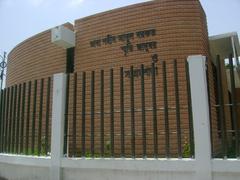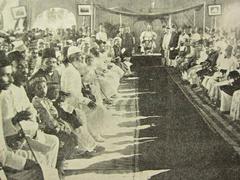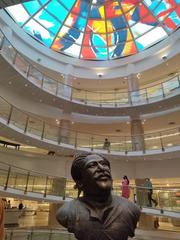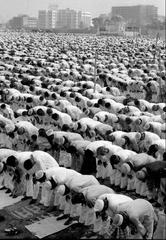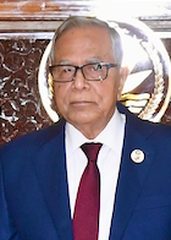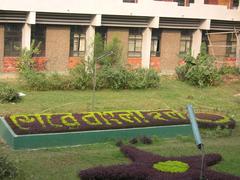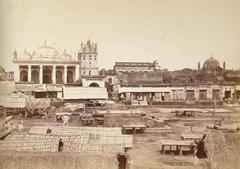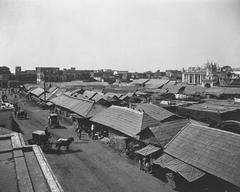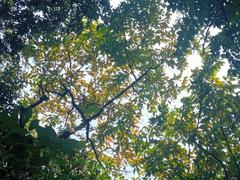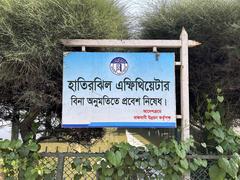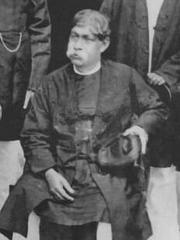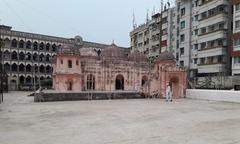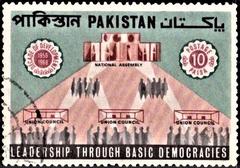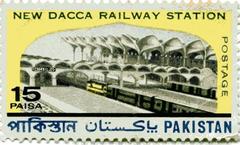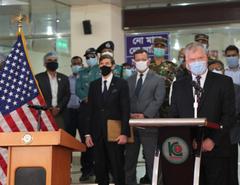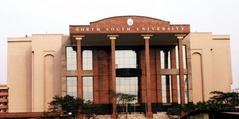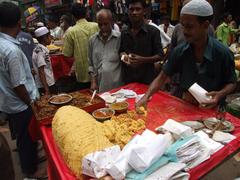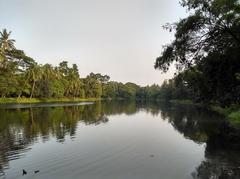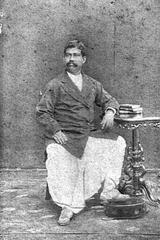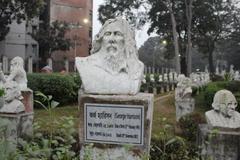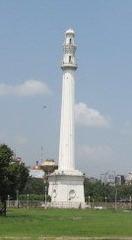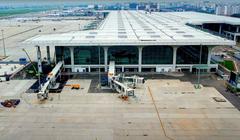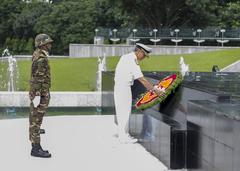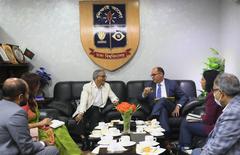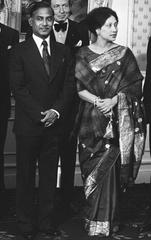
Visiting the Embassy of the United States in Dhaka, Bangladesh: Guide, Tickets, Hours, and Tips
Date: 04/07/2025
Introduction
Visiting the Embassy of the United States in Dhaka offers a unique opportunity to engage with a landmark of historical, diplomatic, and cultural importance. Since its official establishment as an embassy in 1972, following U.S. recognition of Bangladesh’s independence, the mission has evolved into a cornerstone of bilateral relations. Set in the secure Baridhara diplomatic enclave and designed with Mughal Bengali architectural influences, the embassy not only provides essential consular services but also illustrates the deep-rooted partnership between the United States and Bangladesh.
This guide provides a comprehensive overview of the embassy’s history, visiting procedures, security measures, and notable cultural attractions nearby—ensuring you have all the information needed for a meaningful and efficient visit. For the most up-to-date details and to schedule appointments, always consult the official U.S. Embassy Dhaka website.
Contents
- Early Consular Presence and the Path to Embassy Status
- U.S. Recognition of Bangladesh and Embassy Establishment
- Architectural and Cultural Significance
- The Embassy’s Diplomatic Role
- Symbolic Moments and Cultural Ties
- Visiting: Hours, Access, and Security
- Nearby Attractions
- Lalbagh Fort
- Ahsan Manzil
- Dhaka University
- National Museum of Bangladesh
- Contemporary Diplomatic Significance
- Security and Access Considerations
- Frequently Asked Questions (FAQs)
- Conclusion
- Sources
Early Consular Presence and the Path to Embassy Status
The United States established its first consulate in Dhaka (then “Dacca”) in 1949, when the city was part of East Bengal under the Dominion of Pakistan (history.state.gov). This early diplomatic post played a crucial role in monitoring regional developments and providing consular services during times of political transition.
During the 1971 Bangladesh Liberation War, the Consulate-General in Dhaka gained international attention with the “Blood Telegrams”—dispatches from Consul General Archer Blood documenting atrocities committed during Operation Searchlight. These reports influenced U.S. policy debates and highlighted the consulate’s role in upholding human rights (en.wikipedia.org).
U.S. Recognition of Bangladesh and Embassy Establishment
Formal recognition of Bangladesh’s independence by the United States came on April 4, 1972. President Richard Nixon’s message, delivered by Herbert D. Spivack, affirmed the intention to establish full diplomatic relations. In response, Prime Minister Sheikh Mujibur Rahman welcomed the move (history.state.gov).
Bilateral relations were officially launched on May 18, 1972, with the elevation of the consulate to embassy status. Davis Eugene Boster became the first U.S. Ambassador after presenting his credentials in April 1974 (bd.usembassy.gov).
Architectural and Cultural Significance
The current embassy, completed in 1989, sits in Baridhara and was designed by Kallmann, McKinnell and Wood. Its architecture, marked by red terracotta brickwork and Mughal-inspired features, reflects both local heritage and U.S. engagement with Bangladeshi culture (en.wikipedia.org). The campus includes landscaped gardens and a moat, earning it the nickname “Red Fort.” The embassy participates in art preservation initiatives, showcasing works by local and international artists, further fostering cultural exchange (en.wikipedia.org).
The Embassy’s Diplomatic Role
For over five decades, the U.S. Embassy Dhaka has been pivotal in advancing bilateral cooperation. The United States has provided over $8 billion in development aid, supporting areas like disaster response, public health, counterterrorism, and economic growth (bd.usembassy.gov). During the COVID-19 pandemic, Bangladesh received more than 61 million U.S.-donated vaccine doses, underscoring the partnership’s public health dimension.
Trade relations have expanded, with the U.S. importing significant volumes of Bangladeshi apparel, textiles, and footwear, and facilitating dialogue on labor rights and workplace safety (bd.usembassy.gov). The embassy also supports educational exchanges and people-to-people initiatives.
Symbolic Moments and Cultural Ties
Key symbolic events reinforce the enduring relationship between the two nations. Dr. Fazlur Rahman Khan, the first Bangladeshi Fulbright scholar, went on to achieve global acclaim in architecture (bd.usembassy.gov). The banyan tree planted by Senator Edward Kennedy at Dhaka University stands as a living testament to U.S.-Bangladesh friendship.
Cultural programs, educational exchanges, and commemorative events—like the 50th anniversary of diplomatic ties—deepen mutual understanding and cooperation (bd.usembassy.gov).
Visiting the U.S. Embassy Dhaka: Hours, Access, and Security
The embassy primarily serves official, consular, and administrative functions. Public access is limited, and all visits—such as for visa interviews or American citizen services—require appointments. Regular consular hours are Monday to Friday, 8:00 AM to 5:00 PM. Walk-in visits are not permitted (bd.usembassy.gov).
Stringent security protocols are in place. All visitors must present valid identification and pass through security screenings. The embassy does not offer public tours or tickets; only those with scheduled appointments or official business may enter.
Nearby Attractions and Dhaka Historical Sites
A visit to the embassy can be complemented by exploring Dhaka’s rich historical and cultural sites:
- Lalbagh Fort: A 17th-century Mughal complex with gardens, a mosque, and historic tombs.
- Ahsan Manzil: The Pink Palace, once the Nawab’s residence, now a museum of Bengal’s history.
- Dhaka University: Location of the Kennedy banyan tree and historic academic landmarks.
- National Museum of Bangladesh: Extensive exhibits on Bangladesh’s heritage and culture.
Contemporary Diplomatic Significance
Today, the U.S. Embassy in Dhaka employs around 400 staff members. It is a hub for diplomatic engagement on issues such as economic development, security cooperation, regional refugee assistance, climate change, and human rights (en.wikipedia.org; eurasiareview.com).
Bangladesh’s strategic Indo-Pacific location has further elevated its importance in U.S. foreign policy, with the embassy playing a key role in promoting an open, secure, and democratic region (eurasiareview.com).
Security and Access
Located on Madani Avenue in Baridhara, the embassy is within a highly secure diplomatic zone (travel.state.gov). The U.S. government identifies credible security risks for foreigners in Bangladesh, and embassy staff observe travel restrictions within the country. Visitors should plan accordingly and comply with all security measures.
Frequently Asked Questions (FAQs)
Q: What are the U.S. Embassy Dhaka visiting hours?
A: Monday to Friday, 8:00 AM–5:00 PM for consular services, by appointment only.
Q: Is public entry allowed?
A: Only for those with scheduled appointments or official business; no public tours.
Q: What services are provided?
A: Visa processing, U.S. citizen services, and diplomatic engagements.
Q: How do I make an appointment?
A: Through the official embassy website or designated contact channels.
Q: What security procedures should I expect?
A: Strict screening, valid ID required, and compliance with all protocols.
Historical Sites: Lalbagh Fort and Ahsan Manzil
Lalbagh Fort
Overview:
Lalbagh Fort is a 17th-century Mughal complex in central Dhaka, renowned for its striking gardens, mosque, and historical tombs.
History:
Begun in 1678 by Subahdar Muhammad Azam Shah, the fort remains unfinished but stands as a testament to Mughal grandeur (dhakatourism.gov.bd).
Visiting Hours:
- Open daily: 9:00 AM–5:00 PM
- Closed: Fridays, public holidays
Tickets:
- Foreigners: 200 BDT
- Locals: 50 BDT
- Children under 12: Free
(Tickets available at the gate.)
Tips:
- Wear comfortable shoes.
- Bring sun protection and water.
- Guided tours are available and recommended.
Accessibility:
- Wheelchair ramps at main entrances.
- Restrooms and refreshment stalls available.
Nearby:
- Ahsan Manzil, Dhakeshwari Temple, Sadarghat Riverfront.
FAQs:
- Guided tours: Available onsite.
- Online tickets: Not currently available.
- Best time: November–February for pleasant weather.
Resources:
Ahsan Manzil
Overview:
Ahsan Manzil, the Pink Palace, was the residence of the Nawab of Dhaka and is now a museum.
History:
Built in the 19th century, the palace exemplifies Indo-Saracenic Revival architecture and played a pivotal historical role.
Visiting Hours:
- Open daily (except Fridays and national holidays): 10:00 AM–5:00 PM
- Last entry: 4:30 PM
Tickets:
- Adults: 50 BDT
- Children: 20 BDT
- Foreigners: 200 BDT
- Group discounts for 10+ visitors available.
(Tickets at the entrance and online via Bangladesh National Museum)
Key Attractions:
- Grand Durbar Hall
- Royal quarters
- Antique collections
- Riverside gardens
Tips:
- Visit early or late in the day.
- Photography is allowed in most areas.
- Site is accessible for visitors with mobility needs.
Nearby:
- Lalbagh Fort, Dhakeshwari Temple, Sadarghat Riverfront.
FAQs:
- Guided tours: Available onsite.
- Online tickets: Via National Museum website.
- Children: Welcomed and engaged by exhibits.
Conclusion
The U.S. Embassy in Dhaka stands as both a diplomatic institution and a symbol of U.S.-Bangladesh partnership. Visitors must plan ahead, respect security protocols, and schedule appointments for any official business. Exploring nearby landmarks such as Lalbagh Fort and Ahsan Manzil provides a well-rounded perspective on Dhaka’s rich cultural history. Staying informed through official channels and leveraging resources like the Audiala app ensures a safe, informed, and enriching experience in Bangladesh’s capital (bd.usembassy.gov; dhakatourism.gov.bd).
Sources
- U.S. Embassy Dhaka
- Embassy of the United States, Dhaka - Wikipedia
- Bangladesh Country Page, U.S. Department of State
- International Travel Country Information - Bangladesh, U.S. Department of State
- Implications of US Delegations Visit to Dhaka: Strengthening Bangladesh-US Relations, Eurasia Review
- Visiting the Lalbagh Fort in Dhaka: History, Tickets, Hours & Travel Tips, Dhaka Tourism
- Exploring Lalbagh Fort: Visiting Hours, Tickets, and Historical Insights in Dhaka, Dhaka Tourism
- Visiting the Ahsan Manzil: Dhaka’s Iconic Historical Monument - Visiting Hours, Tickets & Tips, Bangladesh National Museum


















































